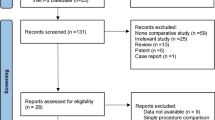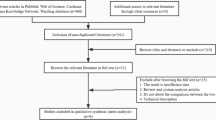Abstract
Background
Unilateral biportal endoscopic (UBE) has been gradually applied in clinical practice. UBE has two channels, with good visual field and operating space, and has achieved good results in the treatment of lumbar spine diseases. Some scholars combine UBE with vertebral body fusion to replace traditional open fusion surgery and minimally invasive fusion surgery. The efficacy of biportal endoscopic transforaminal lumbar interbody fusion (BE-TLIF) is still controversial. In this systematic review and meta-analysis, BE-TLIF and minimally invasive transforaminal lumbar interbody fusion (MI-TLIF) are compared in the efficacy and complications of lumbar degenerative diseases.
Methods
PubMed, Cochrane Library, Web of Science and China National Knowledge Infrastructure (CNKI) were used to search literatures related to BE-TLIF before January 2023, to identify relevant studies, and systematically review all literatures. Evaluation indicators mainly include operation time, hospital stay, estimated blood loss, visual analog scale (VAS), Oswestry Disability Index (ODI), and Macnab.
Results
A total of 9 studies were included in this study; a total of 637 patients were collected, and 710 vertebral bodies were treated. Nine studies showed that there was no significant difference in VAS score, ODI, fusion rate, and complication rate between BE-TLIF and MI-TLIF at the final follow-up after surgery.
Conclusion
This study suggests that BE-TLIF is a safe and effective surgical approach. BE-TLIF surgery has similar good efficacy to MI-TLIF in the treatment of lumbar degenerative diseases. And compared with MI-TLIF, it has the advantages of early postoperative relief of low-back pain, shorter hospital stay, and faster functional recovery. However, high-quality prospective studies are needed to validate this conclusion.
Graphical abstract














Similar content being viewed by others
Data availability
All authors promise that the data are truly available.
References
Buser Z, Ortega B, D’Oro A, Pannell W, Cohen JR, Wang J et al (2018) Spine degenerative conditions and their treatments: national trends in the United States of America[J]. Glob Spine J 8(1):57–67
Guo S, Sun J, Tang G (2013) Clinical study of bilateral decompression via vertebral lamina fenestration for lumbar interbody fusion in the treatment of lower lumbar instability[J]. Exp Ther med 5(3):922–926
Fourney DR, Dettori JR, Norvell DC, Dekutoski MB (2010) Does minimal access tubular assisted spine surgery increase or decrease complications in spinal decompression or fusion?[J]. Spine 35(9 Suppl):S57-65
Stang A (2010) Critical evaluation of the Newcastle-Ottawa scale for the assessment of the quality of nonrandomized studies in meta-analyses[J]. Eur J Epidemiol 25(9):603–605
Egger M, Davey Smith G, Schneider M, Minder C (1997) Bias in meta-analysis detected by a simple, graphical test[J]. BMJ 315(7109):629–634
Gatam AR, Gatam L, Mahadhipta H, Ajiantoro A, Luthfi O, Aprilya D (2021) Unilateral biportal endoscopic lumbar interbody fusion: a technical note and an outcome comparison with the conventional minimally invasive fusion[J]. Orthop Res Rev 13:229–239
Zhu J, Hao Y, Ren Z (2021) Preliminary study of unilateral biportal endoscopic lumbar interbody fusion for the treatment of degenerative spinal disease[J]. Chin J Spine Spinal Cord 61(11):1026–1033
Kong F, Zhou Q, Qiao Y, Wang W, Zhang C, Pan Q et al (2022) Comparison of unilateral biportal endoscopic transforaminal lumbar interbody fusion versus minimally invasive tubular transforaminal lumbar interbody fusion for lumbar degenerative disease[J] 36(05): 592–599
Jiang C, Huang Y, Zuo H, Sun Y, Sun J (2022) Clinical effect of unilateral biportal endoscopic lumbar interbody fusion and minimally invasive transforaminal lumbar interbody fusion on single-segment lumbar stenosis with instability[J]. Acta Acad Med Sin 4(04):563–569
Song X, Hao Y, Ren Z, Yu L, Zhu G, Zhou W (2022) Preliminary study of unilateral biportal endoscopic lumbar interbody fusion for the treatment of grade I lumbar spondylolisthesis[J]. Chin J Min Inv Surg 22(10):814–819
Yu Y, Wang Y, Xie Y, Xu J, Chen Y, Fan X (2022) Comparison of mid-term effectiveness of unilateral biportal endoscopy-transforaminal lumbar interbody fusion with minimally invasive surgery-transforaminal lumbar interbody fusion assisted with three-dimensional microscope in treating lumbar spondylolisthesis[J]. Chin J Reparative Reconstr Surg 1–8
Heo DH, Park CK (2019) Clinical results of percutaneous biportal endoscopic lumbar interbody fusion with application of enhanced recovery after surgery[J]. Neurosurg Focus 46(4):E18
Kim JE, Yoo HS, Choi DJ, Park EJ, Jee SM (2020) Comparison of minimal invasive versus biportal endoscopic transforaminal lumbar interbody fusion for single-level lumbar disease[J]. Clin Spine Surg 34(2):E64–E71
Kang MS, You KH, Choi JY, Heo DH, Park HJ (2021) minimally invasive transforaminal lumbar interbody fusion using the biportal endoscopic techniques versus microscopic tubular technique[J]. Spine J 21(12):2066–2077
Kim JE, Yoo HS, Choi DJ, Hwang JH, Park EJ, Chung S (2020) Learning curve and clinical outcome of biportal endoscopic-assisted lumbar interbody fusion[J]. Biomed Res Int 2020:8815432
Gu S, Li H, Wang D, Dai X, Liu C (2022) Application and thinking of minimally invasive transforaminal lumbar interbody fusion in degenerative lumbar diseases[J]. Ann Transl Med 10(6):272
Xiao Y, Li F, Chen Q (2010) Transforaminal lumbar interbody fusion with one cage and excised local bone[J]. Arch Orthop Trauma Surg 130(5):591–597
Villavicencio AT, Burneikiene S, Roeca CM, Nelson EL, Mason A (2010) Minimally invasive versus open transforaminal lumbar interbody fusion[J]. Surg Neurol Int 1(1):12
Heo DH, Son SK, Eum JH, Park CK (2017) Fully endoscopic lumbar interbody fusion using a percutaneous unilateral biportal endoscopic technique: technical note and preliminary clinical results[J]. Neurosurg Focus 43(2):E8
Heo DH, Lee DC, Kim HS, Park CK, Chung H (2021) Clinical results and complications of endoscopic lumbar interbody fusion for lumbar degenerative disease: a meta-analysis[J]. World Neurosurg 145:396–404
Kim J-E, Choi D-J (2018) Biportal endoscopic transforaminal lumbar interbody fusion with arthroscopy[J]. Clin Orthop Surg 10(2):248–252
Gao X, Gao L, Chang Z, Hao D, Du J, Wu J et al (2022) Case series of unilateral biportal endoscopic-assisted transforaminal lumbar interbody fusion in the treatment of recurrent lumbar disc herniation[J]. Am J Transl Res 14(4):2383–2392
Kim J-E, Choi D-J, Kim M-C, Park EJ (2019) Risk factors of postoperative spinal epidural hematoma after biportal endoscopic spinal surgery[J]. World Neurosurg 129:e324-329
Funding
The National Natural Science Foundation of China (Youth Program), No. 31600779 (to DJF); Yichang Medical and Health Research Project, No. A18-301-30 (to DJF).
Author information
Authors and Affiliations
Corresponding author
Ethics declarations
Conflict of interest
We declare that there is no any known competing financial interests or personal relationships that could have appeared to influence the work reported in this paper.
Ethical approval
Not applicable.
Consent to participate
Not applicable.
Consent for publication
We confirm
-
That the work described has not been published before (except in the form of an abstract or as part of a published lecture, review, or thesis)
-
That it is not under consideration for publication elsewhere
-
That its publication has been approved by all co-authors, if any
-
That its publication has been approved (tacitly or explicitly) by the responsible authorities at the institution where the work is carried out.
Additional information
Publisher's Note
Springer Nature remains neutral with regard to jurisdictional claims in published maps and institutional affiliations.
Rights and permissions
Springer Nature or its licensor (e.g. a society or other partner) holds exclusive rights to this article under a publishing agreement with the author(s) or other rightsholder(s); author self-archiving of the accepted manuscript version of this article is solely governed by the terms of such publishing agreement and applicable law.
About this article
Cite this article
Wang, Q., Chang, S., Dong, JF. et al. Comparing the efficacy and complications of unilateral biportal endoscopic fusion versus minimally invasive fusion for lumbar degenerative diseases: a systematic review and mate-analysis. Eur Spine J 32, 1345–1357 (2023). https://doi.org/10.1007/s00586-023-07588-6
Received:
Revised:
Accepted:
Published:
Issue Date:
DOI: https://doi.org/10.1007/s00586-023-07588-6




